exosuit
Latest
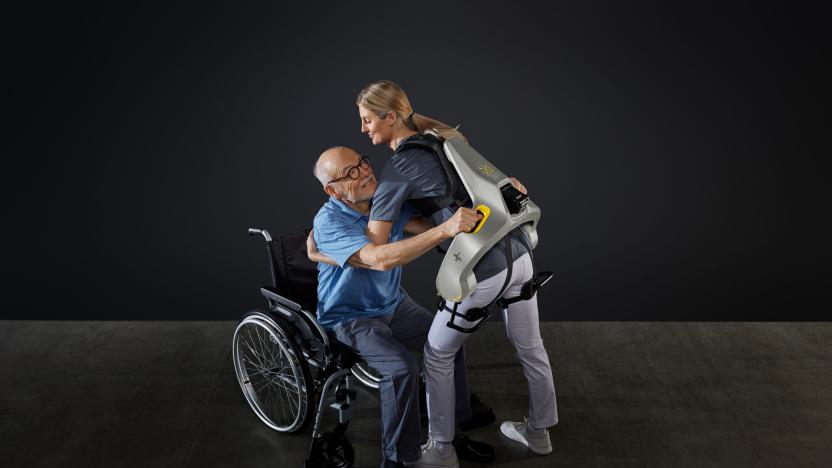
German Bionic’s latest exoskeleton helps healthcare workers lift elderly patients
German Bionic, the robot exoskeleton startup behind the lightweight Apogee exosuit, just revealed the Apogee+, a hardware refresh intended to service health care workers. The powered exoskeleton allows nurses and other health care professionals to have greater access to patients, particularly the elderly and the infirm. The company hopes to decrease the “immense levels of stress endured” by these medical professionals.
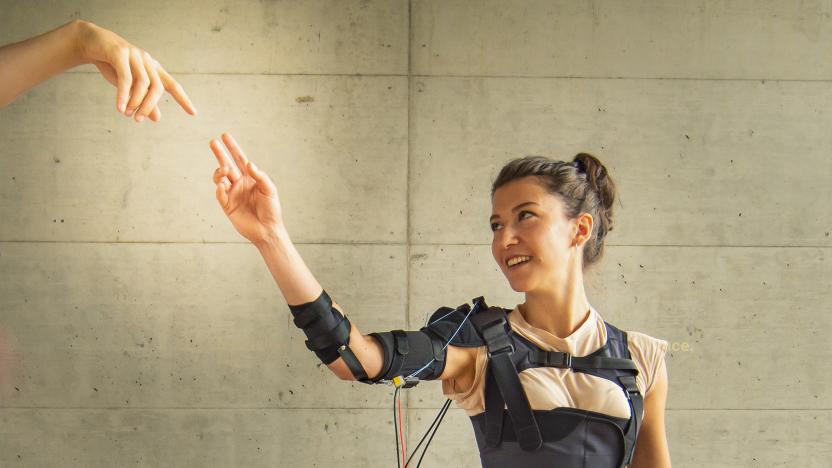
Wearable arm muscles could help overcome upper body injuries
A new wearable arm exoskeleton could provide strength and endurance to people with upper body injuries.
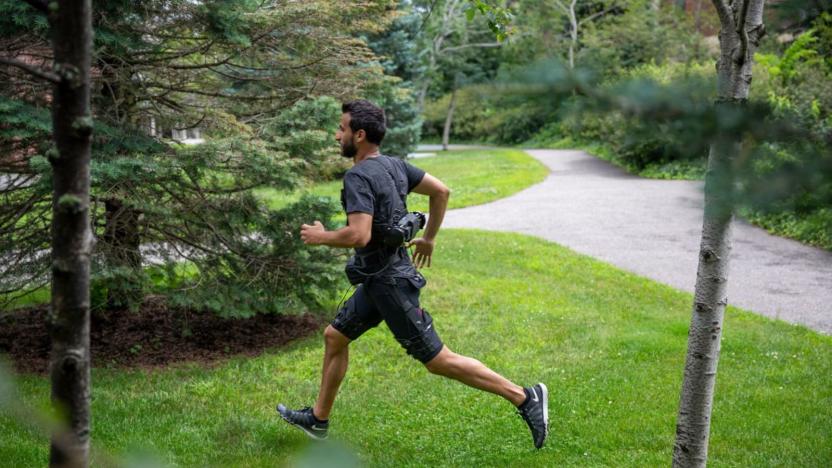
This hip-hugging exosuit uses AI to make walking and running easier
Robotic devices have been used to help people walk or run in rehabilitation settings, but until now, they've been tethered and limited to a single action, like walking or running. In a paper published in Science today, a team of researchers explain how they're going to change that. The researchers -- from Harvard University and the University of Nebraska Omaha -- have developed a portable exosuit that uses AI to assist users with both walking and running.

Cyberdyne's therapeutic cyborg legs arrive in the US
While we're still a ways away from a proper Aliens-esque Power Loader, our enhanced exo-suit future is already upon us. The HAL (that's Hybrid Assistive Limb, not the murderous space AI) from medical device manufacturer, Cyberdyne Inc., has already been leveraged for a number of rehabilitative procedures since being released in Japan in 2011. Cyberdyne announced on Friday that it has teamed with the newly opened Brooks Cybernic Treatment Center of Jacksonville, Florida to make HALs available here in the US.

Robotic shorts can shave minutes off a marathon time
In marathons, milliseconds matter. A split-second can be the difference between victory and defeat; between setting a record and coming in second. So, it's a big deal when a team of Harvard engineers reveal a pair of shorts that reduce an average marathon time from 9:14 minutes/mile to 8:49 minutes/mile.

Lowe's exoskeletons help workers carry what you can't
Exoskeletons aren't just for shipyard workers or people with limited mobility. If Lowe's has its way, they'll help store staff fetch your giant bucket of paint. The home improvement retailer has partnered with Virginia Tech to test prototype passive exoskeletons that make it easier to haul heavy objects. Carbon fiber in the suits' back and legs serves as a "taut bow" that stores energy when you bend down -- that energy comes back the moment you stand back up, making it much easier to lift that heavy bag of concrete. The material's flexible nature should also help the suits feel relatively comfortable... a rather important consideration for warehouse workers who may need to wear it for an entire shift.
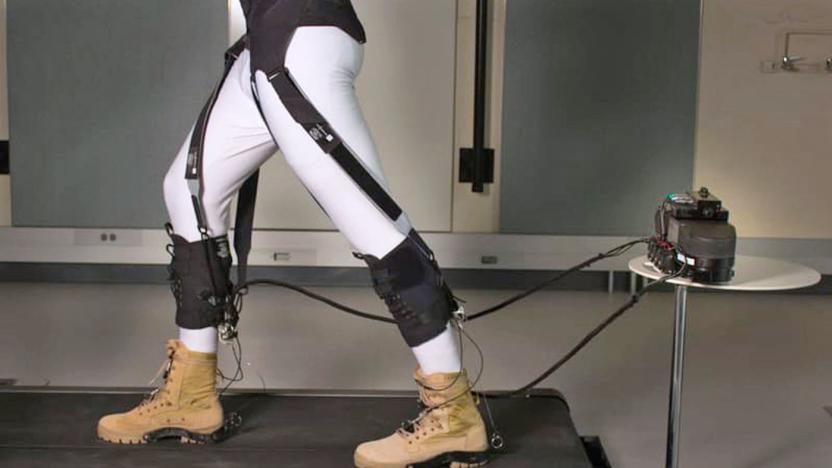
Harvard's soft exosuit makes walking 23 percent easier
Harvard Wyss Institute researchers have been working on a soft exosuit with DARPA's financial help for years. While they were able to present a proof of concept in 2016, it's only now that they've found out just how much the suit can actually help its wearer. According to a new study published in Science Robotics, Harvard's exosuit reduces the energy a user needs to exert while walking by 23 percent. It does that by providing assistive force to the ankle at the perfect moment when you take another step.

ICYMI: Pinterest's photo recognition and light exosuits
try{document.getElementById("aol-cms-player-1").style.display="none";}catch(e){}Today on In Case You Missed It: Pinterest wants users to shop for items by taking pictures, then uploading to the site to find similar items. Carnegie Mellon University invented an exoskeleton component that would lighten suits and make them far easier to walk around in, minus the bulky metal frames. NASA tested a rocket booster this week that may one day go to Mars. As always, please share any interesting tech or science videos you find by using the #ICYMI hashtag on Twitter for @mskerryd.
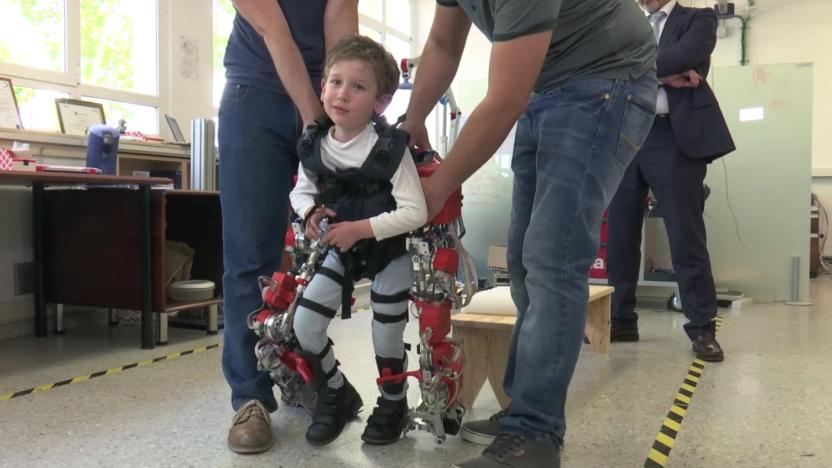
World's first child-sized exoskeleton gets kids on their feet
The Spanish National Research Council, a.k.a. CSIC, has created a kid-sized exoskeleton designed specifically for children suffering from spinal muscular atrophy. Because SMA causes a loss of motor neurons, the patient's body starts to wither away to the point where many child patients end up bedridden and unable to walk. Built from aluminum and titanium, the 26-pound machine uses five assistive motors in each leg to actually help the child keep active and avoid further complications from immobility.

A 'smart' exosuit learns its user's movements
As military and heavy-lifting applications for robotic exoskeletons get closer to reality, the latest trend in wearable machinery is helping the elderly and those with limited mobility get back on their feet. Like their colleagues/competitors at Harvard and ReWalk Robotics, the team behind the Superflex have developed a soft robotic exosuit that could do everything from heavy lifting on the battlefield to replacing grandma's walker.
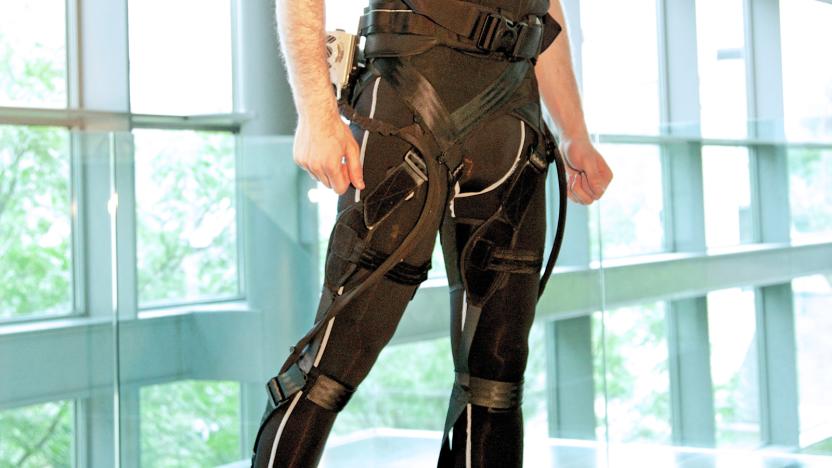
Harvard engineers designed a 'soft wearable robot'
A team of engineers from Harvard University's Wyss Institute for Biologically Inspired Engineering have moved one step closer to a consumer version of a soft, assistive exosuit that could help patients with lower limb disabilities walk again. The Wyss Institute announced today that the university is collaborating with ReWalk Robotics to bring its wearable robotic suit to market.

ICYMI: The best health innovations of the year
#fivemin-widget-blogsmith-image-766185{display:none;} .cke_show_borders #fivemin-widget-blogsmith-image-766185, #postcontentcontainer #fivemin-widget-blogsmith-image-766185{width:570px;display:block;}try{document.getElementById("fivemin-widget-blogsmith-image-766185").style.display="none";}catch(e){}Today on In Case You Missed It: It's been a pretty magical year for medical innovation, with something for everyone but most especially Star Trek fans. The FDA approved 3D-printed medicine for the first time, prosthetic arms for kids got awesome and researchers helped a man with a severed spine walk, with sensor connections on either side of his spine.

The Big Picture: Exploring the deep blue in a wearable submarine
Developed and built by Nuytco Research, this exosuit is made from hard metal and allows divers to operate safely down to a depth of 1000 feet. The suit has four 1.6 horsepower propulsion thrusters, fiber optic gigabit ethernet, and a host of telemetry devices. The "Exosuit atmospheric diving system" (ADS) will allow wearers to work in deep water without facing problems with decompression. While still in testing right now, diver Michael Lombardi will be taking it out for its first full exploration mission later this summer, at a location called Canyons, approximately 100 miles off the coast of Rhode Island.

Tokyo University of Science shows off robotic suit powered by pneumatic artificial muscles (video)
What can one do with a robot suit? Well, it's certainly not limited to just lifting sacks of rice, but that was exactly what we got to do at CEATEC courtesy of Koba Lab from Tokyo University of Science. First seen in 2009, the magic behind this 9kg kit are the pair of pneumatic artificial muscles (aka McKibben artificial muscles) on the back, which are made by industrial equipment manufacturer Kanda Tsushin. When pressurized with air using electrical components from KOA Corporation, the lightweight, loosely-woven PET tubes contract and consequently provide support to the user's back, shoulders and elbows. As such, our arms were able to easily hold two more sacks of rice (making it a total of 50kg) until the demonstrator deflated the muscles. Check out our jolly hands-on video after the break.

RB3D develops Hercule robotic exoskeleton, boosts strength without P90X
Sure, some folks could use a little extra help maneuvering in order to complete daily chores. But what about help with all of that heavy lifting? The folks at RB3D in France have been working with the French Directorate General of Armaments (DGA), ESME Sudria and CES LIST to develop a robotic exoskeleton that will aid in doing just that. Hercule, the aforementioned cobot-esque (collaborative robot) prototype, doesn't require any special training or skills to use. A person needing extra strength to carry that crate of supplies just wears the device and goes about his or her business with the added support of the exosuit. This particular model is powered electrically and will last about 20km (about 12.5 miles) if movement is kept at a regular walking pace. Weight limits, you ask? The Hercule boasts a carrying capacity of 100kg (220lbs) -- more than HAL tech we've seen in aiding travelers in the past. Military and civil customers could get their hands on these as early as 2014, but for now, jump past the break for a look at one in action.

Cyberdyne HAL robotic arm hands-on (video)
If the name Cyberdyne doesn't immediately ring a bell, its HAL (Hybrid Assistive Limb) robotic suit sure will. Here at CEATEC, we bumped into these folks who kindly offered to strap us onto their latest prototype arm -- a slightly smaller variant of the one installed on Cyberdyne's current suit. Most of the HAL's main part was strapped to the outer side of our upper arm with velcro, while our wrist was tied to the much smaller extendable piece; both parts were hinged together with a power unit. Additionally, a sensory pad was applied onto our forearm's medial cutaneous nerve (around the elbow area) to pick up our muscular nerve signal -- similarly, Cyberdyne's lower-body exosuit requires two sensors on each leg. Our HAL was energized as soon as we tensed our arm muscles, so lifting up the tray of four 1.5kg water bottles was a piece of cake consistently throughout the demo -- we even managed it with just our pinky (see video above)! And as soon as Cyberdyne's lovely assistant Fumi turned the dial down, our superhuman powers were instantly taken away. We weren't given any dates or specs for this piece of kit, but if all goes well, we may well see a brand new full-body suit at CES 2012 in January, so stay tuned. Oh, and can someone please get Cyberdyne some WD-40? Zach Honig contributed to this report. %Gallery-135642%

HAL exosuit takes a Cybernic approach to disabled tourism
Cybernics -- it's not a typo, it's a completely new field that mixes cybernetics, mechatronics, and informatics with an all-human core. Pioneered by University of Tsukuba Professor Yoshiyuki Sankai, the Hybrid Assistive Limb (HAL) exosuit originally created to aid Japan's eldery has now found an even nobler mission -- assisting disabled tourists. Through detection of weak muscular bioelectrical impulses in the legs, this RoboCop-like lower body suit boosts its wearer's load-bearing abilities by a whopping 176 pounds. The exoskeleton tech first helped paralyzed Seiji Uchida nearly tackle Switzerland's Breithorn peak in 2006 and is now getting another go at the disabled traveler's bucket list. This time 'round, Uchida hopes his ride atop a HAL-outfitted human will successfully carry him to the top of Normandy's rugged Mont Saint-Michel, paving the way for other similarly handicapped travelers to do the same. Although the robotics in question here is more mech suit than say, dental training real doll, it's still a huge leg up for the nascent research industry that got its kick-start making a wish come true.










